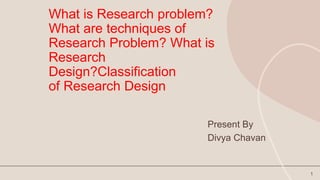
What is Research problem.pptx
- 1. What is Research problem? What are techniques of Research Problem? What is Research Design?Classification of Research Design Present By Divya Chavan 1
- 3. INTRODUCTION A RESEARCH PROBLEM IS A SPECIFIC QUESTION, ISSUE, OR CONCERN THAT A RESEARCHER AIMS TO INVESTIGATE AND ADDRESS THROUGH A RESEARCH STUDY. IT IS A CRITICAL COMPONENT OF THE RESEARCH PROCESS AS IT DEFINES THE SCOPE AND PURPOSE OF THE RESEARCH, GUIDING THE SELECTION OF RESEARCH METHODS, DATA COLLECTION, AND ANALYSIS. A WELL-DEFINED RESEARCH PROBLEM IS ESSENTIAL FOR CONDUCTING MEANINGFUL AND FOCUSED RESEARCH. HERE'S A BRIEF OVERVIEW OF WHAT A RESEARCH PROBLEM IS AND SOME TECHNIQUES FOR FORMULATING ONE:
- 4. Definition of a Research Problem •A research problem is a statement or question that identifies an area of interest or concern and provides a context for the research. •It should be specific, clear, and concise. •The problem should be based on a gap in the current knowledge or a practical issue that requires investigation. •It should be researchable, meaning there are ways to collect data and answer the research question 4
- 6. 6 AREAS THAT NEED FURTHER EXPLORATION. THE REVIEW HELPS YOU UNDERSTAND WHAT HAS ALREADY BEEN DONE AND WHAT REMAINS TO BE INVESTIGATED. OBSERVATION AND EXPERIENCE: SOMETIMES, RESEARCH PROBLEMS ARISE FROM PERSONAL OBSERVATIONS, EXPERIENCES, OR REAL- WORLD ISSUES THAT PIQUE YOUR INTEREST. THESE CAN SERVE AS A FOUNDATION FOR YOUR RESEARCH PROBLEM. EXPERT CONSULTATION: DISCUSS POTENTIAL RESEARCH IDEAS WITH EXPERTS IN THE FIELD. THEY CAN PROVIDE VALUABLE INSIGHTS AND HELP YOU REFINE YOUR RESEARCH PROBLEM. STAKEHOLDER INPUT: IF YOUR RESEARCH IS RELATED TO A SPECIFIC INDUSTRY, COMMUNITY, OR GROUP, GATHER INPUT FROM RELEVANT STAKEHOLDERS. THEIR PERSPECTIVES AND CONCERNS CAN GUIDE THE FORMULATION OF A RESEARCH PROBLEM. CONCEPT MAPPING: CREATE VISUAL REPRESENTATIONS OF THE RELATIONSHIPS BETWEEN DIFFERENT CONCEPTS OR VARIABLES. THIS CAN HELP YOU IDENTIFY GAPS AND CONNECTIONS THAT LEAD TO A RESEARCH PROBLEM.
- 7. 7 1.Brainstorming: Engage in brainstorming sessions with colleagues, advisors, or mentors to generate research ideas. The collective input can help identify potential problems worth investigating. 2.Problem Statement Frameworks: Use problem statement frameworks like the PICO(T) model (Population, Intervention, Comparison, Outcome, Time) for clinical research or the SPICE framework (Setting, Perspective, Intervention, Comparison, Evaluation) for qualitative research to structure your research problem. 3.Surveys and Questionnaires: Collect input from potential research participants through surveys or questionnaires to identify issues or questions that are important to them. This can inform your research problem. 4.Relevance and Significance: Consider the relevance and significance of the problem. Is it important and impactful? Will it contribute to existing knowledge or address a pressing issue? 5.Narrowing and Focusing: Once you have a broad idea, narrow it down and focus on a specific aspect of the problem. This helps make the research more manageable.
- 8. What is Research Design?Classification of Research Design 8
- 9. INTRODUCTION oResearch design is a critical component of any research project, as it outlines the structure and strategy for conducting the research. It is a plan or blueprint that defines the type of data you will collect, how you will collect it, and the methods you will use to analyze and interpret the data. A well-designed research study ensures that the data collected is relevant and reliable, allowing for meaningful conclusions to be drawn. 9
- 10. Research Design 1.Research Objectives: Clearly state the goals and objectives of the research. What do you intend to achieve through your study? 2.Data Collection: Specify the methods and techniques for collecting data. This can include surveys, experiments, observations, interviews, or archival research. 3.Data Analysis: Describe how you will process and analyze the collected data. This involves statistical and/or qualitative analysis methods. 4.Time Frame: Define the timeline for conducting the research and the expected duration of each phase. 5.Sample Selection: Detail how you will select your sample or participants and justify the chosen method. 6.Research Instruments: Specify the tools and instruments you will use to collect data (e.g., questionnaires, surveys, devices). 10
- 11. Classification Of Research Designs oThere are several ways to classify research designs, but one common classification is based on the nature and purpose of the research. Here are some typical research design classifications 11
- 12. 12 1.Descriptive Research Design: This design is used to describe a phenomenon or provide a snapshot of a situation. It doesn't seek to establish causality but focuses on understanding the current state of affairs. Methods include surveys, observations, and content analysis. 2.Exploratory Research Design: This design is used to explore a problem when little is known about it. It often involves informal research methods, such as interviews, focus groups, or pilot studies, to gather preliminary information. 3.Explanatory or Causal Research Design: This type of research is aimed at identifying cause-and-effect relationships between variables. Experimental designs are common in this category, where researchers manipulate an independent variable to observe its effects on a dependent variable. 4.Cross-Sectional Research Design: This involves collecting data from a sample of subjects at a single point in time. It is often used in descriptive research and can help reveal patterns and associations. 5.Longitudinal Research Design: In contrast to cross-sectional design, this approach involves studying the same subjects or units over an extended period to track changes or trends. Cohort studies and panel studies are examples of longitudinal research.
- 13. 1.Quantitative Research Design: This design emphasizes the collection and analysis of numerical data using structured and standardized research instruments. Surveys and experiments are typical quantitative methods. 2.Qualitative Research Design: This design emphasizes the collection of non-numerical data, such as interviews, observations, and content analysis, to understand social phenomena and explore meanings, interpretations, and experiences. 3.Mixed-Methods Research Design: This combines both quantitative and qualitative research methods to provide a more comprehensive understanding of a research problem. 13